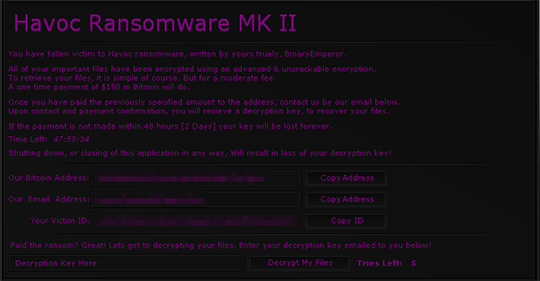RANSOM_HAVOC.A
Ransom.Havoc (Malwarebytes), Trojan.MSIL.Crypt.crxz (Kaspersky)
Windows


Threat Type: Trojan
Destructiveness: No
Encrypted: No
In the wild: Yes
OVERVIEW
Downloaded from the Internet
This Trojan arrives on a system as a file dropped by other malware or as a file downloaded unknowingly by users when visiting malicious sites.
It is capable of encrypting files in the affected system.
TECHNICAL DETAILS
219,648 bytes
EXE
Yes
16 Jan 2017
Connects to URLs/IPs, Encrypts files, Displays graphics/image, Displays message/message boxes
Arrival Details
This Trojan arrives on a system as a file dropped by other malware or as a file downloaded unknowingly by users when visiting malicious sites.
Process Termination
This Trojan terminates processes or services that contain any of the following strings if found running in the affected system's memory:
- Taskmgr
- Antivirus
- Killer
- Process
- Defender
- AntiMalware
- Scanner
- Protection
- AntiVirus
Other Details
This Trojan renames encrypted files using the following names:
- {Original filename and extension}.HavocCrypt
It is capable of encrypting files in the affected system.
NOTES:
This ransomware encrypts all files located in the %Desktop% folder. After encrypting the files, it displays the following ransom note:

If the maximum number of tries for the decryption key is reached, it displays the following:

It also displays these message boxes if the time left reaches zero.


SOLUTION
9.850
13.162.00
16 Jan 2017
13.163.00
17 Jan 2017
Step 1
Before doing any scans, Windows XP, Windows Vista, and Windows 7 users must disable System Restore to allow full scanning of their computers.
Step 2
Restart in normal mode and scan your computer with your Trend Micro product for files detected as RANSOM_HAVOC.A. If the detected files have already been cleaned, deleted, or quarantined by your Trend Micro product, no further step is required. You may opt to simply delete the quarantined files. Please check this Knowledge Base page for more information.
Step 3
Restore encrypted files from backup.
Did this description help? Tell us how we did.

